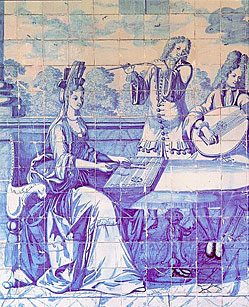Songs & Music
Music in the Late 18th Century
People in the late 18th century enjoyed music at home with family and friends, at parties, taverns, military gatherings, dance parties and balls, in church services, and if they lived in or near cities and had the means, they might attend concerts. There were itinerant music instructors for those who could afford them, and many learned music on their own by ear, never learning to read a note of music. The voice was a popular instrument for both sexes, and as with musical instrument instruction, there were itinerant singing masters and singing schools.

Woman playing a hammered dulcimer, man playing a wooden (or German) flute, and a man playing an English guitar or lute. “Musicos num Terraco,” Wilhelm Van Der Loet, 1707, Courtesy Nogueira da Silva Museum, Braga, Portugal.
Polite and Tavern Music
In kitchens and barnyards, in parlors and taverns, men and women from all walks of life played, sang and listened to music. Some songs had a distinctly political tone, while others celebrated courtship and romance. Drinking songs and tunes with bawdy lyrics appealed to male tavern goers and supper clubs, while other music was especially suited to dancing. The vocal and instrumental music presented here represents the range of secular music popular during the late 18th century.
- Address to the Ladies
- Allemande Swiss
- Juice of Barley
- Over the Hills and Far away
- Rural Felicity
- Hunt the Squirrel
- Successful Campaign
Sacred Music
From the earliest days of settlement, religious services in New England Congregational, or Puritan, meetinghouses included music. Religious beliefs dictated that this music be performed without instrumental accompaniment. By the early 18th century, the abilities of congregations to sing psalms and anthems had been reduced to a cacophony of voices singing multiple tunes and variations, often simultaneously. Ministers seeking to improve the quality of music and worship responded by calling on towns and churches to establish “singing schools.” These singing schools attracted many young people and dramatically altered the nature and variety of sacred music performed in New England meetinghouses. The tunes presented here are representative of the music taught and performed in the late 18th and early 19th centuries.
Martial Music
Audible above the noise and chaos of battle, fifes and drums were indispensable instruments in 18th century armies, both for communicating orders and for raising morale. In addition to playing popular marching tunes, fifers and drummers played out orders on the march, in camp and on the battlefield. The tunes presented here were particularly popular and would likely have been familiar to Massachusetts veterans of the Revolution.
- The Rose Tree
- We Are on the Road to Boston
- The World Turned Upside Down
- Yankee Doodle
- York Fusiliers
About the Artists
The five fife and drum tunes on this site are performed by the Nathan Hale Ancient Fifes and Drums, Inc. The secular music is performed by members from two groups which perform early music: Merry Company (vocals, hammered dulcimer, fiddle, fife and recorder) and Poor Richard's Penny (vocals, Jews Harp and Irish flute). The four sacred music selections are performed by Honest Harmony with members of Merry Company, Poor Richard's Penny, and three staff members from the Pocumtuck Valley Memorial Association.